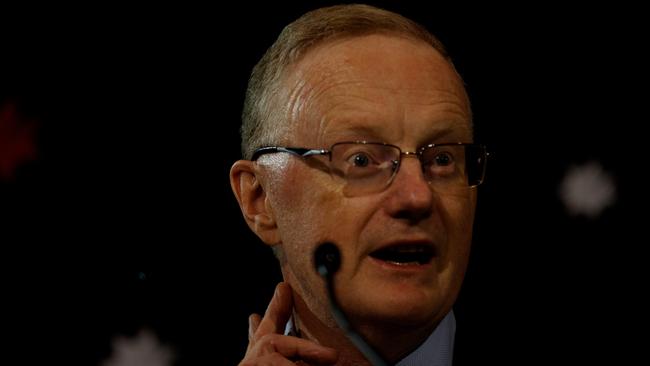Philip Lowe’s wishful thinking on unemployment
Outgoing RBA chief Philip Lowe will unfortunately be remembered more for his interest rate guidance than the fact that unemployment hit a near 50-year low during his watch.
Outgoing RBA chief Philip Lowe will unfortunately be remembered more for his interest rate guidance than the fact that the unemployment rate hit a near 50-year low during his watch.
Of course, markets will be more interested in Michele Bullock’s thoughts on the outlook for inflation and unemployment. But while the central bank has belatedly done a lot to restore confidence in its inflation-fighting credentials, investors should be wary of overly optimistic central bank guidance.
In his Anika Foundation speech, Dr Lowe noted that inflation has on average been consistent with the 2-3 per cent target range during his term as governor, and that inflation expectations have been “well anchored”. He also noted that inflation has been “more variable” than it was in the previous two decades, ranging from a low of minus 0.3 per cent to a high of 7.8 per over the past seven years. He pointed to the increased prevalence of supply shocks and deglobalisation, and climate change, the energy transition and shifts in demographics as factors that “will make it difficult to return to the earlier world in which inflation tracked in a very narrow range.”
“While this doesn’t mean that the inflation target can’t be achieved on average, it does mean that inflation is likely to be more variable around that target,” Dr Lowe said.
It’s hard to argue that these forces won’t cause more volatility in inflation, as they are likely to cause inflation spikes that trigger interest rate hikes, recessions and interest rate cuts and resultant swings in economic activity and inflation. But this misses the point that they are upside risks for inflation.
If Dr Lowe was being completely candid, he would have mentioned the risk that these forces pose sustained upside risks for inflation and the long-run neutral rate of interest or “R-star”.
Similarly, while Dr Lowe can hardly be accused of hubris, there’s a danger in extrapolating his success in lowering the unemployment rate from 6 per cent to 3.5 per cent during his term.
The unemployment rate is the ultimate “lagging indicator”. Its fall was helped by the one-way slide in interest rates after the end of the resources boom early last decade. But the RBA has pushed the cash rate up from a record low of 0.1 per cent to an 11-year high of 4.1 per cent since May 2022 and the impact on the unemployment rate of a sustained rise in interest rates is yet to be seen.
“The current cycle still has a way to run, but it is possible that Australia can sustain unemployment rates below what we have had over the past 40 years,” Dr Lowe said.

It wasn’t a very big call given that the unemployment rate has averaged much higher levels of 6-7 per cent in that period. But again, Dr Lowe misses the point that if interest rates average higher levels than they did in recent years due to higher and more volatile inflation, then the unemployment rate is also likely to average higher levels.
His comments came amid renewed angst in financial markets over signs of renewed inflationary pressure in US ISM services PMI data, which could threaten market expectations that US interest rates have peaked and 100 basis points of cuts are likely by the end of 2024.
Australia’s S&P/ASX 200 share index fell 1.2 per cent to an eight-day low of 7171 points after a three-day fall in the S&P 500 as the US 10-year bond yield again neared its highest point since 2007.
AMP senior economist Diana Mousina cautioned that upside inflation shocks could lead to renewed concern about further rate hikes, higher bond yields and the risk of a recession, which would be negative for sharemarkets.
Inflation data across most major economies had been slowing noticeably over recent months and while it may seem like the fight against inflation had been won by central banks, some recent leading indicators of inflation had ticked up again, which could indicate that inflation may have a resurgence in late 2023 or early 2024 that could take financial markets by surprise, Ms Mousina said.
Upturns in leading indicators of inflation include some price indices in the PMI and ISM surveys, the likelihood of higher agricultural commodity prices, a broader lift in commodity prices, a rise in medium-term inflation expectations and a lift in real wages and higher consumer confidence that could see a rise in consumer spending.
“Inflation could start surprising to the upside again in the near-term, leading to renewed concern about further rate hikes, higher bond yields and the risk of a recession which would be negative for sharemarkets,” she said.
“While this is a risk, we still see inflation headed lower through 2023 and into 2024 due to the impacts of restrictive interest rates, but it is worth watching the leading inflation indicators for signs of persistent upside inflation risks.”
She said that over the medium to long term, inflation was likely to be higher than in the 2010s because of the reversal of globalisation towards on-shoring/friend-shoring, bigger governments, more intervention in sectors, increased defence spending leading to bigger budgets, a decrease in the working age population and an increase in the dependency ratio, and the impacts of climate change.
On a positive note, there may be some offset from productivity improvements related to technology that could help to keep inflation down.







To join the conversation, please log in. Don't have an account? Register
Join the conversation, you are commenting as Logout